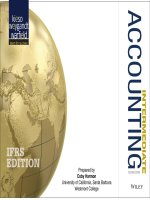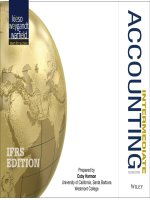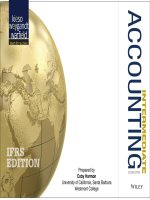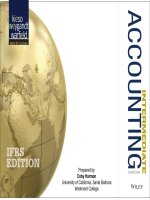Lecture Intermediate accounting (IFRS/e) - Chapter 4: The income statement and statement of cash flows
Bạn đang xem bản rút gọn của tài liệu. Xem và tải ngay bản đầy đủ của tài liệu tại đây (1.89 MB, 41 trang )
Chapter 4
THE INCOME STATEMENT
AND STATEMENT OF
CASH FLOWS
© 2013 The McGraw-Hill Companies, Inc.
An income
statement for a
hypothetical
manufacturing
company that you
can refer to as we
proceed through
the chapter.
4-2
Income
Income from
from Continuing
Continuing Operations
Operations
Revenues
Expenses
Inflows of
resources
resulting
from
providing
goods or
services to
customers.
Outflows of
resources
incurred in
generating
revenues.
4-3
Gains and
Losses
Income Tax
Expense
Increases or
decreases in
equity from
peripheral or
incidental
transactions
of an entity.
Because of
its
importance
and size,
income tax
expense is a
separate
item.
Operating versus Nonoperating Income
4-4
Operating
Income
Nonoperating
Income
Includes revenues
and expenses
directly related to
the principal
revenuegenerating
activities of the
company
Includes gains
and losses and
revenues and
expenses related
to peripheral or
incidental
activities of the
company
Income Statement (Single-Step)
Proper
Heading
Revenues
& Gains
Expenses
& Losses
4-5
Income Statement (Multiple-Step)
Proper
Heading
Gross
Profit
Operating
Expenses
Nonoperating
Items
4-6
U. S. GAAP vs. IFRS
There are more similarities than differences between
income statements prepared according to IFRS and
those prepared according to U.S. GAAP. Some
differences are highlighted below.
•
•
•
4-7
Has no minimum requirements.
•
SEC requires that expenses be
classified by function.
•
“Bottom line” called net income
or net loss.
Report extraordinary items
separately.
•
•
Specifies certain minimum
information to be reported on the
face of the income statement.
Allows expenses classified by
function or natural description.
“Bottom line” called profit or loss.
Prohibits reporting extraordinary
items.
Earnings Quality
Earnings quality refers to the ability of
reported earnings to predict
a company’s future earnings.
Transitory Earnings
versus
Permanent Earnings
4-8
Manipulating Income and
Income Smoothing
“Most executives prefer to report earnings
that follow a smooth, regular, upward path.”
~Ford S. Worthy, “Manipulating Profits: How It’s Done”, Fortune
Two ways to manipulate
income:
1. Income shifting
2. Income statement
classification
4-9
Operating Income and Earnings Quality
4 - 10
Restructuring Costs
Costs associated with shutdown or
relocation of facilities or
downsizing of operations are
recognized in the period incurred.
Goodwill Impairment
and Long-lived Asset
Impairment
Involves asset impairment losses
or charges.
Nonoperating Income and
Earnings Quality
Gains and losses generated from the sale of
investments often can significantly inflate or
deflate current earnings.
How should those
Example
As the stock market boom reached gains be interpreted
in terms of their
its height late in the year 2000,
relationship to
many companies recorded large
future earnings?
gains from sale of investments
that had appreciated significantly Are they transitory
or permanent?
in value.
4 - 11
Separately Reported Items
Reported separately, net of taxes:
Discontinued
operations
4 - 12
Extraordinary items
(under U.S. GAAP, but not IFRS)
Income from continuing operations before income taxes
$xxx
Income tax expense
xx
Income from continuing operations
xxx
Discontinued operations, net of $xx in tax
xx
Net income
$xxx
Intraperiod Income Tax Allocation
Income
Income Tax
Tax Expense
Expense must
must be
be associated
associated with
with
each
each component
component of
of income
income that
that causes
causes it.
it.
Show
ShowIncome
IncomeTax
Tax
Expense
Expenserelated
relatedto
to
Income
Incomefrom
fromContinuing
Continuing
Operations.
Operations.
4 - 13
Report
Reporteffects
effectsof
of
Discontinued
DiscontinuedOperations
Operationsnet
net
of
ofrelated
relatedincome
incometax
taxeffect.
effect.
Reporting Discontinued Operations
The IASB and FASB have been working together to
develop a common definition and a common set of
disclosures for discontinued operations.
The proposed standard defines a
discontinued operation as a “component”
that either:
1.Has been disposed of
2.Is classified as held for sale
4 - 14
Reporting Discontinued Operations
Reporting for Components Sold
Income or loss from
operations of the
component from the
beginning of the reporting
period to the disposal
date
Gain or loss on the
disposal of the
component’s assets.
Reporting for Components Held For Sale
Income or loss from
operations (revenues,
expenses, gains, and
losses) of the component
from the beginning of the
reporting period to the
end of the reporting
period
4 - 15
An “impairment loss” if
the carrying value of
the assets of the
component is more
than the fair value
minus cost to sell.
Unusual or Infrequent Items
Unusual or infrequent items that are
material are included as separate
component of continuing operations or
disclosed in notes to financial statements
4 - 16
Accounting Changes
Type of Accounting
Change
4 - 17
Definition
Change in Accounting
Policy
Change from one acceptable
accounting method to another
Change in Accounting
Estimate
Revision of an estimate
because of new information or
new experience
Change in Accounting Policies
• A change in accounting policy refers to a change
from one acceptable accounting method to
another.
• IFRS requires that voluntary changes in accounting
policy be accounted for retrospectively by revising
prior years’ financial statements.
• For mandated changes in accounting policies,
companies are required to account for the change
according to the requirements in that new or
updated standard. If not specified, companies are
required to account for the change retrospectively.
4 - 18
Change in Depreciation or Amortization
Method
A change in depreciation,
or amortization method is
treated the same as a
change in accounting
estimate.
4 - 19
Change in Accounting Estimate
Revision of a previous
accounting estimate
Use new estimate in
current and future
periods
Includes changes in
depreciation or
amortization methods
4 - 20
Correction of Accounting Errors
Errors occur when transactions are either
recorded incorrectly or not recorded at all.
Errors
Discovered in
Same Year
Material Errors
Discovered in
Subsequent
Year
4 - 21
Reverse original erroneous journal
entry and record the appropriate
journal entry.
Record a prior period adjustment to
the beginning retained earnings
balance in a statement of changes in
shareholders’ equity.
Previous years’ financial statements
that are incorrect as a result of the
error are retrospectively restated to
reflect the correction.
Earnings per Share Disclosure
One of the most widely used ratios is earnings per
share (EPS), which shows the amount of income
earned by a company expressed on a per share basis.
Basic EPS
Net income less preference dividends
Weighted-average number of ordinary
shares outstanding for the period
4 - 22
Diluted EPS
Reflects the potential dilution that could
occur for companies that have certain
securities outstanding that are convertible
into ordinary shares or share options that
could create additional ordinary shares if
the options were exercised.
Earnings per Share Disclosure
Report EPS data separately for:
1. Income (loss) from continuing
operations
2. Income (loss) from discontinued
operations
3. Net Income (loss)
4 - 23
Comprehensive Income
An expanded
version of income
that includes gains
and losses that
traditionally have
not been included
in income
statements.
4 - 24
Other Comprehensive Income
Comprehensive income includes traditional net income
as well as additional gains and losses that change
shareholders’ equity.
1. Net unrealized gains (losses) from investments (net of tax).
2. Gains and losses due to reviewing assumptions or market returns
differing from expectations and prior service cost from amending the
postretirement benefit plan.
3. When a derivative designated as a hedging instrument for a cash
flow hedge is adjusted to fair value, the gain or loss is deferred as a
component of comprehensive income and included in earnings later,
at the same time as earnings are affected by the hedged transaction.
4. Gains or losses from changes in foreign currency exchange rates.
The amount could be an addition to or reduction in shareholders’
equity. (This item is discussed elsewhere in your accounting
curriculum).
4 - 25









